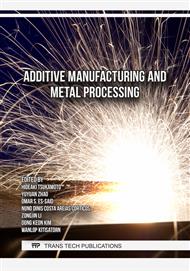[1]
C.A. Wenner, C.G. Drury, Analyzing human error in aircraft ground damage incidents, Int. J. Ind. Ergon. 26 (2) (2000) 177–199.
DOI: 10.1016/S0169-8141(99)00065-7
Google Scholar
[2]
M. A. Caminero, I. García-Moreno, and G. P. Rodríguez, Experimental study of the influence of thickness and ply-stacking sequence on the compression after impact strength of carbon fiber reinforced epoxy laminates, Polym. Test., vol. 66, no. February, p.360–370, 2018.
DOI: 10.1016/j.polymertesting.2018.02.009
Google Scholar
[3]
V. S. Anuse, K. Shankar, R. Velmurugan, and S. K. Ha, Compression-After-Impact analysis of carbon fiber reinforced composite laminate with different ply orientation sequences, Int. J. Impact Eng., vol. 167, no. May, p.104277, 2022.
DOI: 10.1016/j.ijimpeng.2022.104277
Google Scholar
[4]
D. Ghelli and G. Minak, Low velocity impact and compression after impact tests on thin carbon/epoxy laminates, Compos. Part B Eng., vol. 42, no. 7, p.2067–2079, 2011.
DOI: 10.1016/j.compositesb.2011.04.017
Google Scholar
[5]
S. Rivallant, C. Bouvet, E. Abi Abdallah, B. Broll, and J. J. Barrau, Experimental analysis of CFRP laminates subjected to compression after impact: The role of impact-induced cracks in failure, Compos. Struct., vol. 111, no. 1, p.147–157, 2014, doi:10.1016/j.compstruct. 2013.12.012.
DOI: 10.1016/j.compstruct.2013.12.012
Google Scholar
[6]
N.A. Nassir and M.R. Gharkan, Impact response of composite laminates based on epoxy and glass fibre, Mater. Today Proc., vol. 42, p.1901–1907, 2021.
DOI: 10.1016/j.matpr.2020.12.229
Google Scholar
[7]
A.P. Sharma, S.H. Khan, and R. Velmurugan, Effect of through thickness separation of fiber orientation on low velocity impact response of thin composite laminates, Heliyon, vol. 5, no. 10, p. e02706, 2019, doi: 10.1016/j.heliyon. 2019.e02706.
DOI: 10.1016/j.heliyon.2019.e02706
Google Scholar
[8]
H. Singh, K. K. Namala, and P. Mahajan, A damage evolution study of E-glass/epoxy composite under low velocity impact, Compos. Part B Eng., vol. 76, p.235–248, 2015.
DOI: 10.1016/j.compositesb.2015.02.016
Google Scholar
[9]
N.K. Naik, R. Ramasimha, H. Arya, S.V. Prabhu, and N. ShamaRao, Impact response and damage tolerance characteristics of glass-carbon/epoxy hybrid composite plates, Compos. Part B Engineering, vol. 32, no. 7, p.565–574, 2001.
DOI: 10.1016/S1359-8368(01)00036-1
Google Scholar
[10]
A. Rogani, P. Navarro, S. Marguet, J. F. Ferrero, and C. Lanouette, Study of post-impact behaviour of thin hybrid carbon/epoxy and glass/epoxy woven composite laminates under fatigue tensile loading – Part I: Experimental study, Compos. Struct., vol. 260, p.113449, 2021.
DOI: 10.1016/j.compstruct.2020.113449
Google Scholar
[11]
K. C. Nagaraja, S. Rajanna, G. S. Prakash, P. G. Koppad, and M. Alipour, Studying the effect of different carbon and glass fabric stacking sequence on mechanical properties of epoxy hybrid composite laminates, Compos. Commun., vol. 21, no. July, p.100425, 2020.
DOI: 10.1016/j.coco.2020.100425
Google Scholar
[12]
Anuse, V.S., K.,S., Velmurugan, R., & Ha, S.K., Compression-After-Impact analysis of carbon/epoxy and glass/epoxy hybrid composite laminate with different ply orientation sequences. Thin-Walled Structures, 185, 110608, 2023.
DOI: 10.1016/j.tws.2023.110608
Google Scholar
[13]
D. Chen, Q. Luo, M. Meng, and G. Sun, Low velocity impact behavior of interlayer hybrid composite laminates with carbon/glass/basalt fibres, Compos. Part B Eng., vol. 176, no. June, p.107191, 2019.
DOI: 10.1016/j.compositesb.2019.107191
Google Scholar
[14]
C. V. Opelt, G. M. Cândido, and M. C. Rezende, Compressive failure of fiber reinforced polymer composites – A fractographic study of the compression failure modes, Mater. Today Commun., vol. 15, no. January, p.218–227, 2018.
DOI: 10.1016/j.mtcomm.2018.03.012
Google Scholar
[15]
Lin, S., Ranatunga, V., & Waas, A. M., Experimental study on the panel size effects of the Low-Velocity Impact (LVI) and Compression After Impact (CAI) of laminated composites, Part I: LVI. Composite Structures, 296, 2022.
DOI: 10.1016/j.compstruct.2022.115822
Google Scholar
[16]
Lin, S., Ranatunga, V., & Waas, A. M., Experimental study on the panel size effects of the low velocity impact (LVI) and compression after impact (CAI) of laminated composites, part II: CAI. Composite Structures, 295, 2022.
DOI: 10.1016/j.compstruct.2022.115824
Google Scholar
[17]
D7136 ASTM International. Standard test method for measuring the damage resistance of a fiber-reinforced polymer matrix composite to a drop-weight impact event. ASTM International, 2007.
DOI: 10.1520/d7136_d7136m-05e01
Google Scholar
[18]
D7137 ASTM International. Standard Test Method for Compressive Residual Strength Properties of Damaged Polymer Matrix Composite Plates.
DOI: 10.1520/d7137_d7137m
Google Scholar


